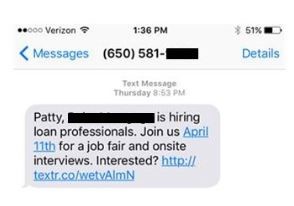-
Get the message: it’s a new age of candidate recruiting
Posted by Lisa B. Radloff on August 4th, 2016 
In a recent Deloitte study, 78% of mobile users reported that they check their phones within the first hour of waking up, with most claiming to look at their phones within five minutes. And what are they most likely to check first? Text messages. Of course it follows that text message campaigns are now becoming a powerful recruiting option.
The numbers are impressive.
According to Beyond.com, text message recruiting reports an astounding 97% average open rate and 30% average response rate within the first hour. In a recent campaign, an NAS client, needing to hire for many openings at a Call Center, logged 300 responses in just three hours.
So, how do you craft the messaging and manage the campaign? What are key rules and best practices associated with text message recruiting? Here is a sample of a recruitment message:

Let’s break it down.
How long? The Global System for Mobile Communications, which sets the standards for the global mobile market, standardized 160 for the length of a text message across all carriers. However the ideal, industry-standard length for a recruitment text message is 100 characters.Concise content is king. Be mindful of your audience and the medium. This is not an online job posting or an eblast; your goal is to craft a brief message with basic facts, and always include a link for candidates to learn more. Text message links typically direct candidates to a landing page promoting an event, an RSVP portal or directly to the ATS to apply.
Frequency. One message per 35 days is the established rule. Although text message recipients are opt-in, it’s considered spam to send additional follow-up communications that are not driven by initial candidate reply. If candidates invite you to communicate with them, it doesn’t mean you should start texting them every time a new job appears. Be cognizant of what people want and how frequently they want it. Which brings us to…
Opt-in only. Unless you’ve been explicitly invited to communicate with candidates via text, you don’t want to go there. If you do, you risk legal ramifications, not to mention you’re going to do nothing but irritate your potential candidates. You’ll need to find candidates who have opted in for text messages either through your Talent Network or a list vendor.

Be mindful of your targeted demographic. In our experience, metropolitan areas with more tech-savvy mobile users tend to have a high response rate. Conversely, rural areas pose a unique challenge in that there may not be enough candidates, in which case text campaigns often elicit a low response rate. In this case, your recruitment efforts may be better served through a local radio spot or print ad.
You control your campaign.
Text recruitment allows recruiters to reply to responses through a dashboard on their desktop or mobile device that transmits via text back to the candidate’s phone, while masking the recruiter’s personal contact information. In addition, text recruitment portals offer advantages such as:
- Both recruiters and candidates are able to log in and opt in/out of content based on preferences
- Two-way, real-time communication between recruiters and candidates is possible
- You can view and manage reporting metrics to quickly measure the success of the campaign
- You can personalize each text message to maximize engagement potential
Take it to the next level.
Text recruitment is quickly evolving as an effective, personalized communication tool in the recruitment landscape. A recent Pew Research Report revealed that after taking photos, texting was the number one activity on smart phones. The reality is that to market to candidates, it is to your advantage to connect with them via their preferred method of communication. For many, that is increasingly text messaging.
The bottom line: text messaging is on every mobile device, and your next great hire may be just a message away.
Lisa B. Radloff



